 | Published by
The Mountaineers Books
1001 SW Klickitat Way, Suite 201
Seattle, WA 98134 |
1974, 1980, 1988, 1997, 2002 by The Mountaineers Books
All rights reserved
First edition 1974. Second edition 1980. Third edition 1988. Fourth edition: first printing 1997, second printing 1998. Fifth edition: first printing 2002, second printing 2005, third printing 2006
No part of this book may be reproduced in any form, or by any electronic, mechanical, or other means, without permission in writing from the publisher.
Published simultaneously in Great Britain by Cordee, 3a DeMontfort Street, Leicester, England LE1 7HD
Manufactured in the United States of America
Copyediting: Watershed Books
Illustration: Hans Neuhart
Cover and book design: The Mountaineers Books
Typography and book layout: Watershed Books
All photographs by Gene Prater unless otherwise noted
Cover photograph: Snowshoes walking on mountain EyeWire Back cover photograph: 2002 Keoki Flagg for Atlas Snow-Shoe Co.
Cataloging-in-publication data on file at the Library of Congress
 Printed on recycled paper
Printed on recycled paper

Preface to the Fifth Edition
Since the appearance of the third edition of Gene Prater's book in 1988, snowshoeing has experienced a rediscovery and enjoyed increased popularity. Snowshoeing has long been considered the authority on the sport, but with so many changes in the industry, the book was becoming out of date. Gene died suddenly in 1993, before he could undertake the necessary revisions, so The Mountaineers Books approached me with the task of revising his text. I was honored to be asked to update this classic.
Gene's book was my introduction to snowshoeing, and little did I know how much more I was about to learn by undertaking this project. From my years of snowshoeing experience, along with the research for this editing project, I have found that although new ideas and equipment have been important, the basic principles of snowshoeingwhich come naturally from wanting to walk in snoware the same after 6,000 years. And the snowflakes of winter have not changed at all.
I first met Gene's daughter, Connie Prater, and his son, Eric Prater, to discuss the book and their father, which helped me tremendously to retain the flavor of the book and character of the man I had never met. Thanks to you both and also to Gene's brother, Bill Prater, and former wife, Yvonne Prater, who have been most helpful with insights into Gene's earlier years. Even though Gene and I never met, I now stay in contact with his family and have realized that if we haven't been on the trail together in a past life, we will be in the next one.
The help on this fifth edition came in two categories: a new chapter on history and many additional new photographs. The basis of the snowshoe history being expanded into its own chapter comes from an out-of-print book, The Snowshoe Book, (third edition, 1983) by William E. Osgood and Leslie Hurley, originally published by the former Stephen Greene Press. It has been my other snowshoe reference book since my own snowshoe beginnings. I tracked Bill, now retired and the surviving co-author, to a small community in northwestern Vermont. Thanks to Bill's enthusiastic help and permission, many of the words on the older history are his, since he did it so well.
Those other contributors supplying the more modern history that is blended into the new chapter include Bill Prater, Yvonne Prater, Connie Prater, Carl Heilman, Ed Kiniry, Kathy Murphy, Lynn Cariffe, Kris Koprowski, Tom Sobel, Karen Righthand, Dave Powers The Mountain Man, and my on-snow companions, Malcolm Stephens and Bill Opdyke. Special thanks go to my technical adviser and consultant, Skip Greene, retired/active, of Rocky Mountain Rescue and a specialist in mountain operations.
The responsibility for the second category, the photographs, was new to me. I could not have done it without the many photos supplied by Tubbs Snowshoe Company, Redfeather Snowshoes, Atlas Snow Shoe Company, the artistic photos from Carl Heilman, the illustrative action photos taken by Malcolm Stephens, and the historic photo from the Nancy Kavanagh Collection. I also included material from my own BIGfoot Snowshoe Tour slide show. Thank you all for the enticing scenes, alluring locations, and descriptive images.
Deb Easter is the new-editions coordinator who enticed me out of retirement and talked me into editing the fifth edition. My managing editor, Kathleen Cubley, kept me on track within reasoneven though I am among the few writers out there who don't like to use computers. The Business Connection, in my small mountain town of Nederland, Colorado, allowed technology to catch up with my preferred forty-five-year-old mechanical Royal typewriter. Dave White and Bill Eikenberry alleviated my frustrations with their modern wonders of electronics and computers. Thanks to you all for your understanding and knowledge.
Sales figures for snowshoes are still increasing at such a rate that if I were to record the current numbers they would be obsolete by the time this book is in print. The manufacturers of what we now call modern Western snowshoes have increased from just a few to at least two dozen since the third edition. The traditional laced wood-frame showshoes are still being made, but their sales percentage is declining, while new companies are competing for better designs, lower prices, and more customer sales. Increased competition will be to the consumer's advantage, and will probably weed out those companies that make inferior products or products that don't give good value relative to cost. However, the old-style wood-frame snowshoes will still be sold and used, since many snowshoers continue to prefer this traditional form.
BIGfoot Says
This sidebar is a new feature for the fifth edition. After many years of being on the snow, teaching and learning through my own BIGfoot Snowshoe Tours, there is much information to share, emphasize, or reinforce. Throughout the book you will find observations, discoveries, tips, and factoids that will make your snowshoeing experience more enjoyable, a little easier, and even safer. Take mental notesthe quiz will be on the snow.
The reader should be aware that even after the printing of this fifth edition, more changes will be coming in design. In order to compensate for the unknown, remember that the snowshoe design is basic and that snowflakes still fall, so this text is written to be flexible. With knowledge from this book, a newcomer to snowshoeing should be able to ask the right questions and apply the answers to what is newthen, whether novice or master, head for the new-fallen snow to have some fun.
Dave Felkley

Gene Prater's Preface to His Third Edition
Those are funny-looking things on your feet. What do you use them for?
These are snowshoes. They have a light frame with webbing or decking laced to it. I strap them to my boots and they are large enough so I can walk on the snow without sinking very deep. It's kind of dismal and depressing to be stuck indoors all winter. I really enjoy a snow hike to remind me that my world doesn't shrink down to surfaced roads and cities just because there's some snow on the ground.



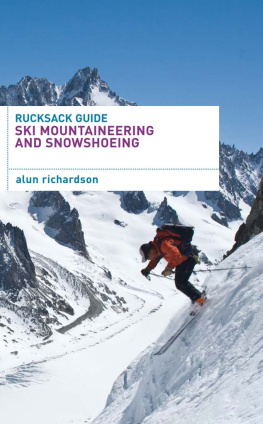
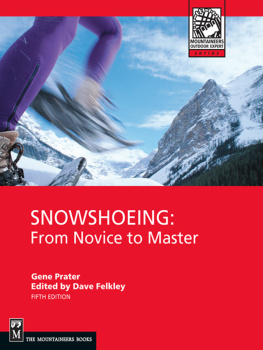
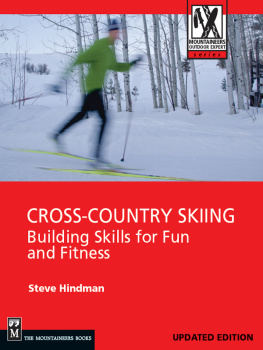

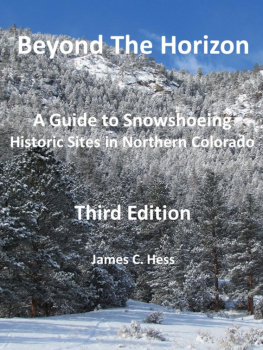
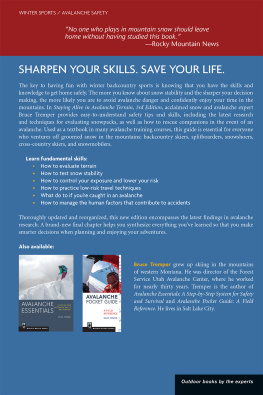

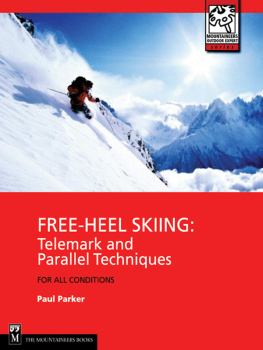
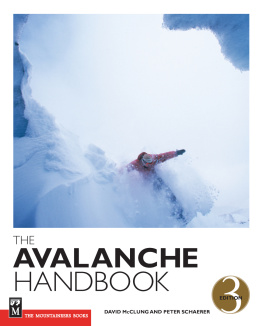


 Printed on recycled paper
Printed on recycled paper
